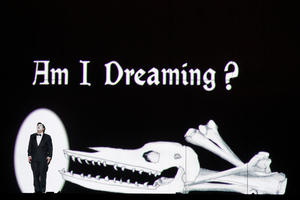Review: THE MAGIC FLUTE Brings New Life to a Classic at Lyric Opera
Enjoy a novel and reimagined take on Mozart's final and beloved opera

A boy and girl falling in love, a vengeful mother-in-law hunting an alleged kidnapper, and ... a group of Freemasons completing their initiation rituals? Mozart's The Magic Flute is full of surprises at Chicago's Lyric Opera. For opera fans, the greatest surprise of all may be the show's unusual production style which relies exclusively on a projected animated backdrop for both set and props, hearkening back to the Nickelodeon era of the 1910s. Spectators who delight in edgy and creative reinterpretations of classic pieces will be sure to enjoy this production-but those who appreciate the extravagance of the traditional opera may find it wanting.
The Magic Flute falls under the opera category of singspiel- that is, there are spoken parts as well as sung parts, much like a musical. This cleverly designed production projected the spoken parts onto a screen instead of having the actors recite them, similar to silent films of yesteryear. Though quirky, this worked with the style of the show (and probably made the plot easier to understand for non-speakers of German). This reinterpretation of The Magic Flute was first given to us by Barrie Kosky in 2012 and has been performed internationally ever since. I found many of the animated projections to be a mixed bag in terms of quality and effectiveness. Though some of the scenes were truly dazzling and ornate, others seemed to be overly detracting from the music.
 However distracting the visual animation was at times, the music was sublime. Each performer displayed masterful vocal quality, emotion, and nuance. The explosive orchestra conducted by Karen Kamensek took my breath away from the very first note, and worked in perfect harmony with the powerful songs performed onstage. The first voice we hear is that of Prince Tamino, played by the talented Pavel Petrov as he is sprinting through a forest, evading his attacker. Petrov's tenor was just as magical as his flute, weaving seamlessly together with his Princess Pamina played by the elegant Ying Fang. Fang sang her numbers with a quiet kind of strength, striking that delicate balance between vulnerability and perseverance.
However distracting the visual animation was at times, the music was sublime. Each performer displayed masterful vocal quality, emotion, and nuance. The explosive orchestra conducted by Karen Kamensek took my breath away from the very first note, and worked in perfect harmony with the powerful songs performed onstage. The first voice we hear is that of Prince Tamino, played by the talented Pavel Petrov as he is sprinting through a forest, evading his attacker. Petrov's tenor was just as magical as his flute, weaving seamlessly together with his Princess Pamina played by the elegant Ying Fang. Fang sang her numbers with a quiet kind of strength, striking that delicate balance between vulnerability and perseverance.
The real star of the show was Huw Montague Rendall in the role of Papageno, the loveable bird catcher who serves as Tamino's companion on his journey. Rendall's presence onstange nearly always brough delight to the audience as he charmed us with his perpetual quest for love. As the performance was drawing to a close, I privately wished for more of Papageno- and I was pleasantly surprised by the show's ending- you'll have to see for yourself to find out why!
Tareq Nazmi and Brenton Ryan performed the roles of the high priest Sarastro and his wicked servant Monostatos, respectively. Nazmi's booming tenor echoed throughout the theater and added a layer of austerity to this already mysterious character. Ryan's portrayal of Monostatos was utterly captivating despite bringing to life a villain so thoroughly repulsive. The way he pursued Pamina made one's skin crawl- and yet it was impossible to look away.
Finally, Lila Dufy as The Queen of the Night reigned supreme in this most powerful of operatic roles. If there's any piece of opera you're familiar with, it's the vengeful and menacing Der Holle Rache- and Dufy executed it brilliantly. I was surprised to find this most intense of queens portrayed as a larger-than-life spider projected onto a screen, engulfing the whole of the stage whenever she made an appearance. The only physical feature of Dufy one could see was her head. Although this portrayal was powerful and unique, there was something in me that so longed to see Dufy throwing her physical arms into her powerfully complex pieces.
Much like the animated projection used throughout the performance, the costumes and wigs for The Magic Flute were unusual for an opera to say the least as they were designed to match fashion of the 1910s. Though Papageno is traditionally outfitted in ornate bird-like garb, he was dressed in a bright green suit and hat- making him stand out, but not dramatically so. The three ladies were charmingly clothed in cloche hats and wielding long cigarette holders, which worked well with their characters. However, Princess Pamina's black and white frock with her bobbed haircut bore a closer resemblance to the Starburst Little Lad than to a royal princess.
Lyric's The Magic Flute brought to life a new spin on a time-honored masterpiece. This production's innovative style will challenge audiences who are used to a more traditional style- but if you are looking for something truly novel in the world of opera, it's a must-see.
The Magic Flute runs through November 27th, 2021. Tickets can be purchased here.
Photo credit: ©Cory Weaver/Lyric Opera Chicago.
Add Your Comment
Videos
